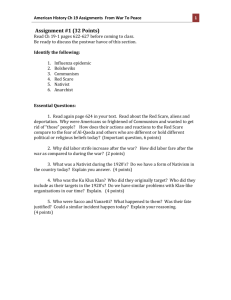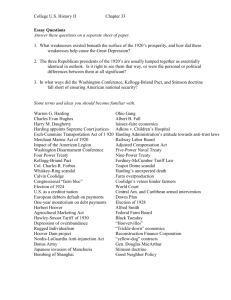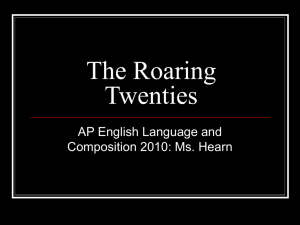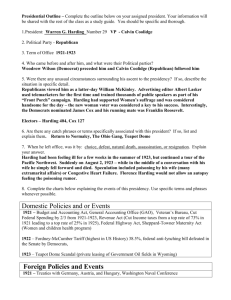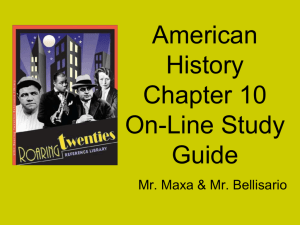Chapter 10
advertisement
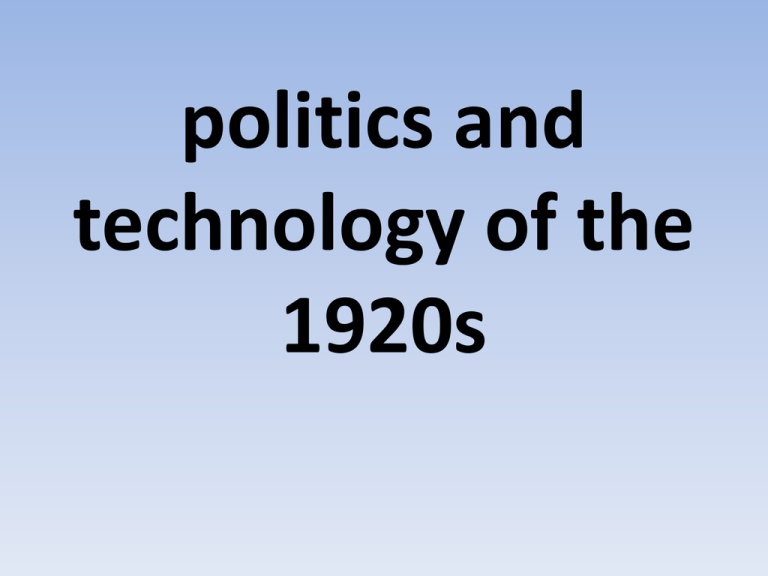
politics and technology of the 1920s Warren G. Harding • He won the Presidential election of 1920. • He ran under the campaign slogan of “return to normalcy” following WWI. • Promised a lack of foreign influence in country’s affairs • While on vacation in San Francisco, he died of a heart attack at age 57. • Vice President Calvin Coolidge then became the 30th President of the U.S. The Teapot Dome Scandal • This was one of many scandals under the Harding Administration. • Albert Fall was the Secretary of the Interior. • Fall secretly allowed people to lease government land containing Navy oil reserves in Teapot Dome Wyoming. • In return, Fall received $300,000. • Fall would become the first cabinet member to go to prison. The Ohio Gang • This was a group of men all from Ohio that Harding gave important positions to. • Most of these men all played cards with Harding before he became President. • Many eyewitnesses have said that they all drank, smoked cigars, and played poker. • Some members of this group used their positions to sell government jobs. • This corruption and scandal helped to define Harding’s term in office. The Ohio Gang in the White House “The air would be heavy with tobacco smoke, trays with bottles containing every imaginable brand of whiskey…cards and poker chips at hand—a general atmosphere of waistcoat unbuttoned, feet on desk, and spittoons alongside.” Harding’s Legacy • He is remembered most for the scandals of his administration • The drinking and partying of the “Ohio Gang” and his extramarital affairs • Some say he would have been impeached had he not died • To protect him his wife burned most (about 7/8) of his personal documents Calvin Coolidge • When Harding died in office August 2nd, 1923, Coolidge became President. • Coolidge was on vacation at his family’s farm in Plymouth Notch Vermont. • His father woke him at 2:30 am on August 3rd and told him that Harding was dead. • Later that morning, Coolidge took the oath of office from his father standing in the family living room. His father was a justice of the peace. • He returned public trust to the office of president Henry Ford • Father was born in Ireland; parents were farmers • Born in Michigan • Age of 15 began taking apart watches…became known as the town watch-smith • Moved to the city to become a machinist apprentice and eventually began studying the technology of cars Ford and Edison Assembly Line • The assembly line was first used by Ford Motor Company. • He used this to cut down the time it took to make a car. • He believed that all cars should be made the same to cut down on time. • He first used the assembly line at his plant in Highland Park Michigan in 1913. • Using the assembly line it took 93 minutes to build a car where it used to take 12 hours. • Fordism = mass production of low priced good coupled with higher worker wages • He was able to reduce workdays from 6 to 5. $5 Dollar Work Day • Shocked the country by offering $5 a day ($110 per day in current money) • Revolutionized “welfare capitalism”– believed that by making his workers happy they wouldn’t leave and they would work harder • This made Detroit one of the most prosperous cities in the country (things have changed a bit) 1913 Ford Assembly Line Model T • The first assembly line product was the Model T also called the “Tin Lizzie.” • This also helped drop the price from $850 to $295. • The automobile became an accepted part of American life. • By the mid-1920s there were many competitors: most notably General Motors and Chrysler • 21 of 26 families owned cars but did not have indoor plumbing. 1908 Model T Advertisement Mr. and Mrs. Ford in his first car Ford on his Model-T "I will build a car for the great multitude. It will be large enough for the family, but small enough for the individual to run and care for. It will be constructed of the best materials, by the best men to be hired, after the simplest designs that modern engineering can devise. But it will be so low in price that no man making a good salary will be unable to own one—and enjoy with his family the blessing of hours of pleasure in God's great open spaces.” The Story of Us: Henry Ford & the Model T How Cars Changed Society: • Cars let people live further out in the suburbs and commute to jobs in the city • Cars greatly increased the demand for oil…now for the first time ever we have road-side gas stations • Rubber industry explodes…Goodyear tires and others come onto the scene • Increased the freedom of citizens to move around the country at will without being dependent on so many factors (railroads, tickets, times, etc) New Consumer Products Since Americans were working less and making more money, new products were introduced to take advantage of disposable income. Some new inventions or products of the 1920’s: 1. Electric Razor 6. Frozen Foods 2. Hair Dye 7. Electric Iron 3. Vacuum Cleaner 8. Washing Machine 4. Glass Cookware 9. Mouthwash 5. Deodorant Airline Industry • 1903 the Wright brothers make their first flight • By 1928 – 48 airlines were serving 355 American cities • Now the USA is also connected by air Charles Lindbergh • In 1927, Charles Lindbergh made the first solo flight across the Atlantic Ocean • Plain was called the “Spirit of St. Louis” • He had formerly been a US Mail pilot Lindbergh part 2 • He did not have a parachute or a radio because he needed to save weight. • He only packed a few things: 1. Razor 3. 5 Sandwiches 2. Passport 4. Quart of Water • The flight took him over 33 hours and 3,605 miles to reach Paris. • He landed at Le Bourget airfield in Paris with more than 100,000 people there to cheer him on. • This established “Lindy” as an international celebrity. New York Times, May 21st, 1927 “Early in the morning on May 20, 1927 Charles A. Lindbergh took off in The Spirit of St. Louis from Roosevelt Field near New York City. Flying northeast along the coast, he was sighted later in the day flying over Nova Scotia and Newfoundland. From St. Johns, Newfoundland, he headed out over the Atlantic, using only a magnetic compass, his airspeed indicator, and luck to navigate toward Ireland. The flight had captured the imagination of the American public like few events in history. Citizens waited nervously by their radios, listening for news of the flight. When Lindbergh was seen crossing the Irish coast, the world cheered and eagerly anticipated his arrival in Paris. A frenzied crowd of more than 100,000 people gathered at Le Bourget Field to greet him. When he landed, less than 34 hours after his departure from New York, Lindbergh became the first person to fly solo across the Atlantic Ocean.” The Radio Industry • In 1920 the Westinghouse Company broadcast the election of President Harding. • This broadcast by radio station KDKA in Pittsburgh was the first long-range broadcast in history. • National Broadcasting Company (NBC) and Columbia Broadcasting System (CBS) were competing against each other from coast to coast. • Hire bands, entertainers, make shows, etc to compete • Radio helped to link the nation together. • By 1929 10 million radios were in use across the country. • Now the country was linked through media for instant access to the news Live Radio Band Radio Assembly Line Production Mass advertisement in the media begins The invention of sliced bread!!!! Easy Consumer Credit • People starting having confidence in the economy • They believed in the “Buy now, pay later” pitch • 75% of radios and 60% of automobiles in the 1920s were bought on installment plans • This was a COMPLETELY new way of purchasing smaller goods in America Uneven Prosperity • Farming in American had been in a depression since 1921 • Farmers earned 1/3rd the income of city workers • A bushel of wheat that sold for $2.94 in 1920 dropped to $1 in 1929 and 30 cents in 1932. Personal Debt and Income Distribution in the 1920s Other Economic Danger Signs Uneven Prosperity Personal Debt • The rich got richer • Huge corporations rather than small business dominated industry. • Many Americans believed that they could count on future income to cover debt. They bought on installment plans boasting “easy terms.” Playing the Stock Market • The rapid increase of stock prices encouraged: • Speculation, the practice of making high-risk investments in hopes of getting a huge return, and • Buying on margin, the practice of allowing investors to purchase a stock for only a fraction of its price and borrow the rest at high interest rates. Too Many Goods, Too Little Demand • Rising productivity had brought prosperity, but it also created a surplus of goods. Manufacturers had more product than consumers could buy. Trouble for Farmers and Workers • Farmers unable to pay their debts defaulted on bank loans, which caused rural banks to fail. Coolidge vetoed a farm relief bill. • While companies grew wealthy, many factory workers remained poor, especially in distressed industries.

